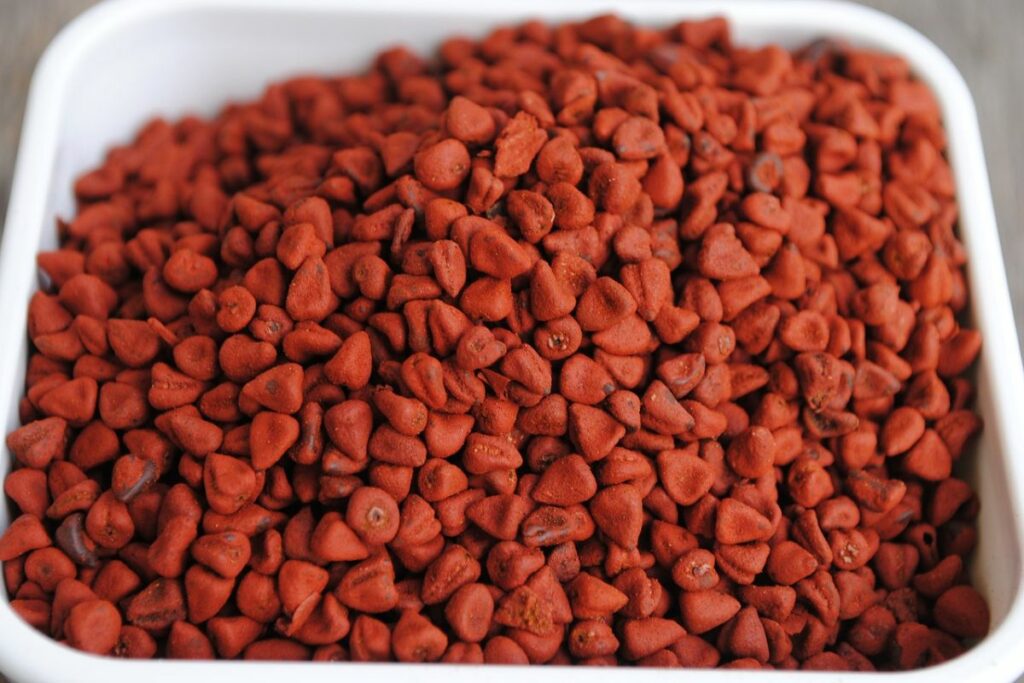Annatto powder is a popular ingredient used in many dishes for its vibrant color and mild peppery flavor. However, it may not always be readily available in every kitchen. Fortunately, there are several substitutes that can be used to replace annatto powder without compromising the taste or color of the dish.
One of the most common substitutes for annatto powder is hibiscus powder. Hibiscus powder has a deep red color that can mimic the color of annatto powder and is often used as a natural dye. Other substitutes include turmeric, beet powder, paprika, nutmeg, saffron, red pepper, safflower, ginger, or hemp seeds. Each substitute has its own unique flavor and benefits, so it is important to understand the ratios and how they compare to annatto powder.
Using annatto substitutes can be a great way to add variety to your dishes and experiment with different flavors and colors. Whether you are looking to replace annatto powder due to dietary restrictions or simply because it is not available, there are plenty of options to choose from. With a little bit of experimentation, you can find the perfect substitute that works best for your recipe.
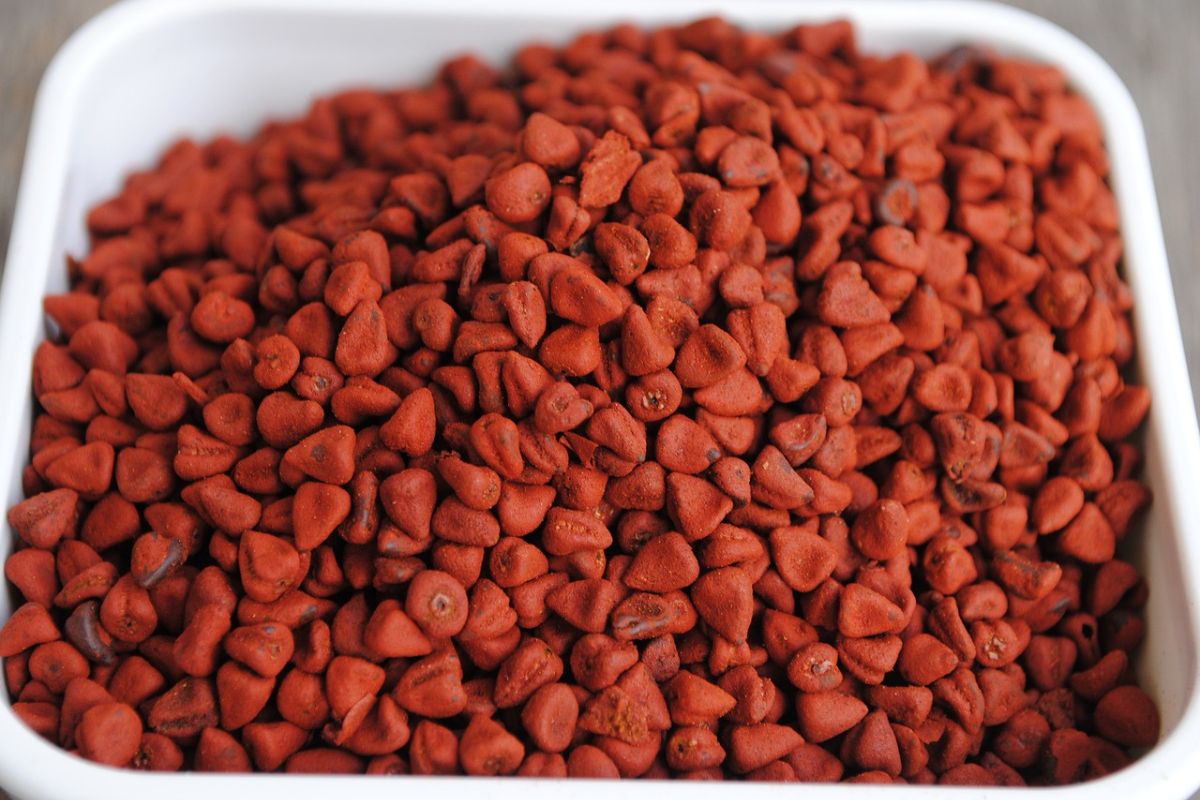
Contents
- 1 Understanding Annatto
- 2 Why Substitute Annatto?
- 3 Common Annatto Substitutes
- 4 Using Spices as Substitutes
- 5 Annatto in Different Forms
- 6 Annatto in Cooking
- 7 Annatto in Beverages and Cosmetics
- 8 Health Benefits of Annatto
- 9 Availability and Storage of Annatto
- 10 Price and Alternatives
- 11 Annatto in Different Cuisines
- 12 Cultural Significance of Annatto
- 13 Other Annatto Substitutes
Understanding Annatto
Annatto, also known as achiote, is a spice commonly used in Latin American and Caribbean cuisine. It is derived from the seeds of the evergreen Bixa orellana tree, which is native to tropical regions of the Americas. The seeds themselves are small and triangular in shape, and have a hard, reddish-brown exterior.
Annatto is primarily used as a coloring agent, providing a vibrant red-orange hue to foods. It is also used as a spice or seasoning, adding a sweet and mildly peppery flavor to dishes. In some cultures, annatto is also used for medicinal purposes, such as treating diarrhea and other digestive issues.
Annatto seeds are often ground into a powder, which can be used in a variety of dishes, including stews, rice dishes, and sauces. The powder can also be mixed with oil or water to create a paste, which can be used as a marinade or rub for meats.
While annatto is a popular ingredient in Latin American and Caribbean cuisine, it may be difficult to find in some areas. Fortunately, there are several substitutes that can be used in its place. Paprika, for example, can provide a similar color and flavor profile. Turmeric, safflower, and beet powder are also commonly used as annatto substitutes.
Overall, annatto is a versatile and flavorful spice that can add both color and taste to a variety of dishes. Whether you’re cooking up a classic Latin American dish or experimenting with new flavors, annatto is definitely worth trying out.
Why Substitute Annatto?
Annatto is a spice that is commonly used in Latin American, Caribbean, and Filipino cuisine. It is known for its vibrant red-orange hue and mildly peppery flavor. However, there are times when you may need to substitute annatto for various reasons. Here are some of the reasons why you may need to substitute annatto:
Annatto may not be readily available in your local grocery store or market. In such cases, you may need to look for a substitute that is readily available.
Allergies
Some people may be allergic to annatto. In such cases, you may need to substitute annatto with another spice or food coloring.
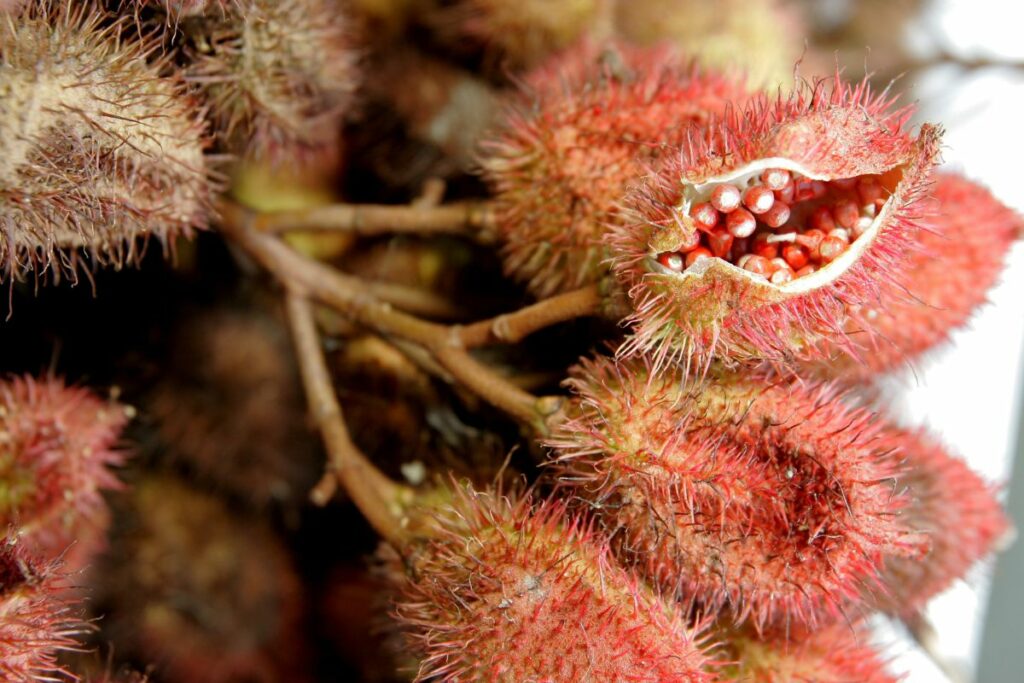
Flavor
Annatto has a unique flavor that may not be suitable for some dishes. In such cases, you may need to use a substitute that has a similar flavor profile or complements the dish.
Food Coloring
Annatto is often used as a natural food coloring. However, if you don’t have annatto, you can use other natural food colorings such as hibiscus powder, turmeric powder, beet powder, or paprika.
Dye
Annatto is also used as a dye in cosmetics, textiles, and other products. If you don’t have annatto, you can use other natural dyes such as beet juice, turmeric, or saffron.
Substitutes for Annatto
There are several substitutes for annatto that you can use in your dishes. Some of the best substitutes for annatto include paprika, turmeric, hibiscus powder, beet powder, and nutmeg. These substitutes provide a similar reddish-orange color to food and have a slightly sweet and smoky flavor.
Overall, there are several reasons why you may need to substitute annatto. Whether it’s due to unavailability, allergies, flavor, food coloring, or dye, there are several substitutes that you can use in your dishes.
Common Annatto Substitutes
Annatto is a spice that is commonly used in Latin American and Caribbean cuisine to add a vibrant red-orange hue to dishes. However, if you don’t have annatto on hand, there are several substitutes that can be used to achieve a similar color and flavor profile. Here are some of the most common annatto substitutes:
Paprika
Paprika is a spice made from ground red peppers and is a great substitute for annatto because it provides a similar reddish-orange color to food. Additionally, both spices have a slightly sweet and smoky flavor. Paprika is commonly used in Hungarian and Spanish cuisine and is available in sweet, hot, and smoked varieties.

Turmeric
Turmeric is a spice that is commonly used in Indian and Middle Eastern cuisine and has a bright yellow-orange color. While it doesn’t provide the same reddish-orange color as annatto, it can be used as a substitute in dishes where color is not the primary concern. Turmeric has a slightly bitter, earthy flavor and is often used in curries, rice dishes, and soups.
Saffron
Saffron is a spice that is commonly used in Mediterranean and Middle Eastern cuisine and has a bright yellow color. While it is more expensive than annatto, it can be used as a substitute in dishes where a golden yellow color is desired. Saffron has a distinctive floral, honey-like flavor and is often used in rice dishes, stews, and seafood dishes.
Hibiscus
Hibiscus is a flower that is commonly used as a natural food coloring and has a bright red color. It can be used as a substitute for annatto in dishes where color is the primary concern. Hibiscus has a slightly tart, fruity flavor and is often used in teas, cocktails, and desserts.
Beet
Beet powder is a natural food coloring that has a bright red color and can be used as a substitute for annatto in dishes where color is the primary concern. Beet powder has a slightly earthy, sweet flavor and is often used in smoothies, baked goods, and desserts.
Safflower
Safflower is a plant that is commonly used as a natural food coloring and has a bright yellow color. It can be used as a substitute for annatto in dishes where a golden yellow color is desired. Safflower has a neutral flavor and is often used in baked goods, sauces, and dressings.
Overall, there are several common annatto substitutes that can be used in a variety of dishes. Whether you use paprika, turmeric, saffron, hibiscus, beet, or safflower, each substitute has its own unique flavor and color profile that can enhance the taste and appearance of your dishes.

Using Spices as Substitutes
When it comes to finding a substitute for annatto, spices can be a great option to consider. Not only do they add flavor and aroma to your dishes, but they can also provide a similar color to annatto.
One popular spice that can be used as a substitute for annatto is turmeric. This spice is commonly used in Indian and Middle Eastern cuisine and has a bright yellow-orange color that can mimic the color of annatto. It also has a mild, earthy flavor that can add depth to your dishes.
Another spice that can be used as a substitute for annatto is paprika. This spice is commonly used in Latin American markets and has a rich, smoky flavor that can add a unique taste to your dishes. It also has a bright red color that can mimic the color of annatto.
If you’re looking for a spice that has a similar flavor profile to annatto, you might consider using curry powder. This spice blend typically includes turmeric, cumin, coriander, and other spices that can provide a similar taste to annatto. However, it’s important to note that curry powder can have a higher spice level than annatto, so you may want to adjust the amount you use accordingly.
When using spices as substitutes for annatto, it’s important to keep in mind that they may not provide the exact same flavor or color as annatto. However, they can still be a great option to consider if you’re unable to find annatto or simply want to try something new in your cooking.
Annatto in Different Forms
Annatto, also known as achiote, is a spice derived from the seeds of the achiote tree. It is commonly used as a natural food coloring and flavoring in Central and South American, Caribbean, and Filipino cuisine. Annatto is available in various forms, including powder, seeds, paste, and oil.
Annatto Powder
Annatto powder is the most commonly used form of annatto. It is made by grinding the dried seeds of the achiote tree into a fine powder. Annatto powder is used to add color and flavor to a variety of dishes, including rice, stews, soups, and sauces. It has a mild, slightly sweet flavor and a bright orange-red color.
Achiote Seeds
Achiote seeds are the whole seeds of the achiote tree. They are used in a similar way to annatto powder, but they require a longer cooking time to release their flavor and color. Achiote seeds are often toasted and then ground into a powder before use.

Achiote Paste
Achiote paste is a blend of annatto powder, vinegar, garlic powder, and other spices. It is commonly used in Mexican and Central American cuisine to marinate meat, poultry, and fish. Achiote paste has a tangy, slightly spicy flavor and a bright orange-red color.
Annatto Oil
Annatto oil is made by infusing vegetable oil with annatto seeds. It is commonly used in Caribbean and Filipino cuisine to add color and flavor to dishes like rice, stews, and soups. Annatto oil has a nutty, slightly sweet flavor and a bright orange-red color.
Other Annatto Substitutes
If annatto is not available, there are several substitutes that can be used to add color and flavor to dishes. Some of the most common substitutes include hibiscus powder, beet powder, safflower powder, ground paprika, and garlic powder. These substitutes can be used in the same way as annatto powder or achiote seeds to add color and flavor to dishes.
Annatto in Cooking
Annatto is a popular spice used in many dishes to add a vibrant red-orange color and a slightly sweet and peppery flavor. It is commonly used in Latin American, Caribbean, and Filipino cuisines. However, if you don’t have annatto powder on hand, there are several substitutes you can use instead.
Annatto is often used in soups, stews, and sauces to add color and flavor. It can also be used to add color to oil, rice dishes, curries, and salads. In baked goods, annatto can be used as a natural food coloring. It is also a common ingredient in marinades for meats.
In Filipino cuisine, annatto is a key ingredient in dishes such as kare-kare, a peanut-based stew, and in the seasoning mix used for adobo, a popular meat dish. In Spanish cuisine, annatto is often used in paella and risotto dishes to add color. In vinaigrettes, annatto can be used to add color and a subtle flavor.
Annatto can even be used in unexpected ways, such as in butternut squash soup to add a vibrant color and a hint of sweetness. When using annatto in cooking, it’s important to adjust the ratio to your liking and to experiment with different substitutes if necessary.
Overall, annatto is a versatile spice that can be used in a variety of dishes to add color and flavor. However, if you don’t have annatto powder on hand, there are several substitutes you can use to achieve similar results.
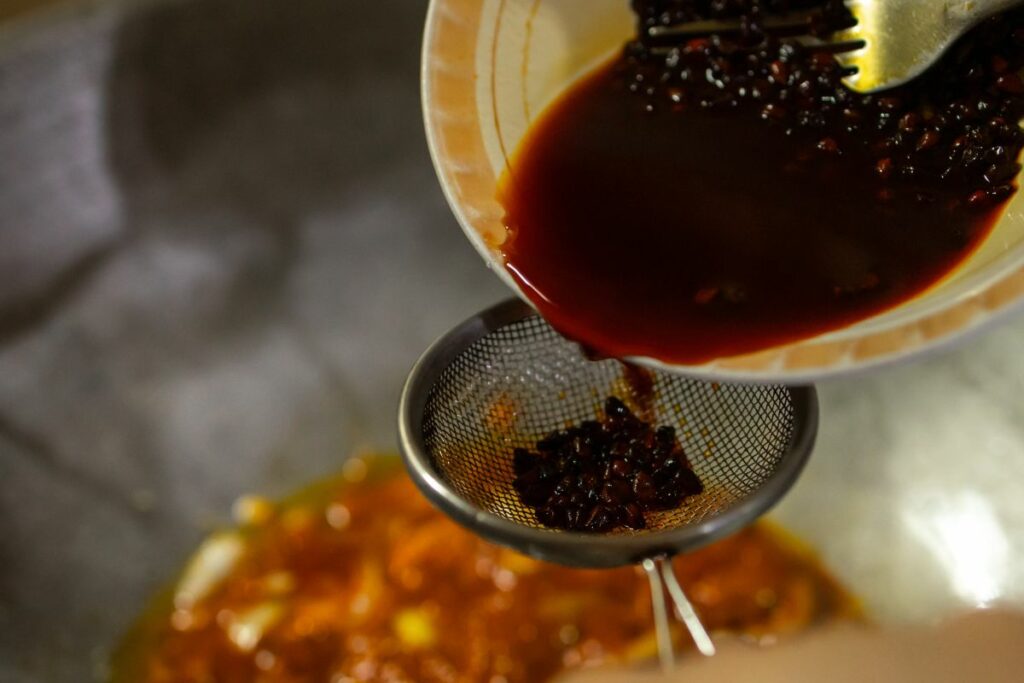
Annatto in Beverages and Cosmetics
Annatto is a popular ingredient in many beverages and cosmetics due to its bright, ruby-red color. It is commonly used as a natural dye to add color to products without the use of synthetic dyes.
In beverages, annatto is often used to add color to fruit juices, sports drinks, and energy drinks. It can also be found in alcoholic beverages such as beer and wine. The addition of annatto not only adds a vibrant color to the drinks but also provides an antioxidant boost.
In cosmetics, annatto is used as a natural colorant in many products such as lipsticks, eyeshadows, and blushes. It is also used in skincare products due to its antioxidant properties. Annatto is believed to help protect the skin from free radical damage and premature aging.
Annatto is also a popular ingredient in smoothies due to its antioxidant properties. It can be added to smoothies for an extra boost of antioxidants and a pop of color.
Overall, annatto is a versatile ingredient that can be used in a variety of products. Its bright, ruby-red color and antioxidant properties make it a popular choice in the beverage and cosmetic industries.
Health Benefits of Annatto
Annatto is a natural food coloring derived from the seeds of the achiote tree. It is commonly used in Latin American, Caribbean, and Filipino cuisine to add color and flavor to dishes. In addition to its culinary uses, annatto has several potential health benefits.
Antioxidant Properties
Annatto contains carotenoids, which are natural pigments that give fruits and vegetables their bright colors. Carotenoids also act as antioxidants, which means they can help protect cells from damage caused by harmful molecules known as free radicals. In particular, annatto contains a type of carotenoid called bixin, which has been shown to have strong antioxidant activity 1.
Anti-inflammatory Effects
Inflammation is a natural response to infection or injury, but chronic inflammation can contribute to a variety of health problems, including heart disease, diabetes, and cancer. Some research suggests that annatto may have anti-inflammatory effects. In one study, rats fed a diet supplemented with annatto extract had lower levels of inflammation markers compared to rats fed a control diet 1.
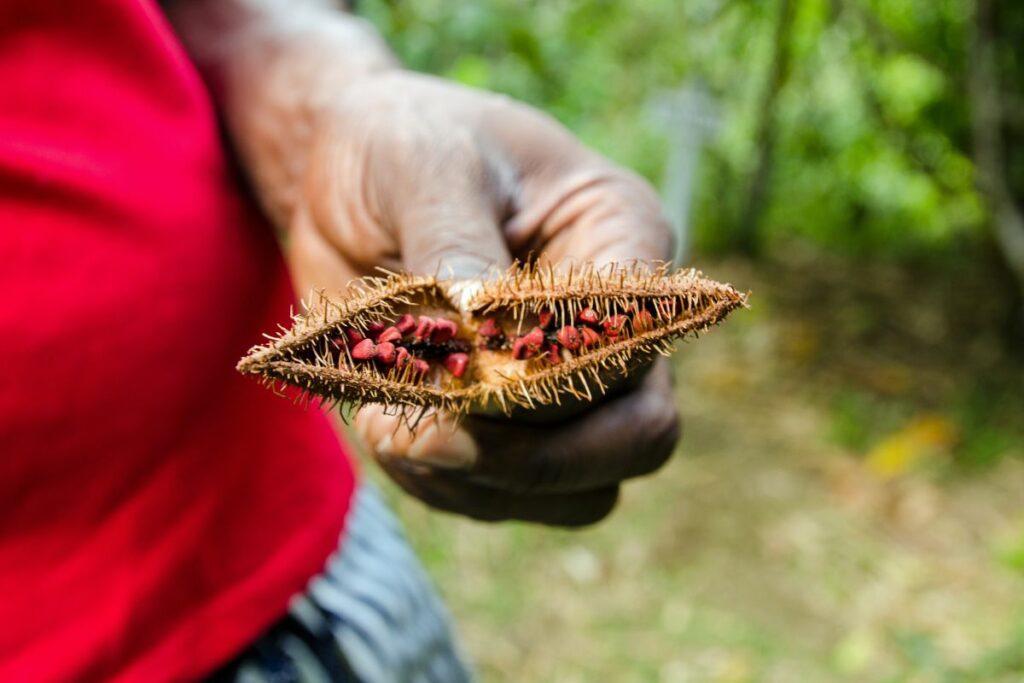
Antimicrobial Properties
Annatto may also have antimicrobial properties, which means it can help fight off harmful bacteria and other microorganisms. In test-tube studies, annatto extracts were shown to inhibit the growth of various bacteria, including E. coli and Staphylococcus aureus 1.
Other Potential Benefits
Some research suggests that annatto may have other health benefits as well. For example, one study found that annatto extract could help protect against age-related cognitive decline in rats 1. However, more research is needed to confirm these findings and determine the optimal dose of annatto for maximum health benefits.
Overall, annatto is a natural food coloring that may offer several potential health benefits. While more research is needed to fully understand its effects, adding annatto to your diet may be a simple and tasty way to support your health.
Availability and Storage of Annatto
Annatto is a spice that is widely available in grocery stores and online. It is commonly sold in the form of whole seeds, ground powder, or paste. Annatto seeds can be found in the spice section of most grocery stores or in specialty stores that carry Latin American or Caribbean ingredients. Ground annatto powder and annatto paste can also be found in the same section.
When it comes to storage, it is important to keep annatto in an airtight container in a cool, dry place away from direct sunlight. Whole annatto seeds can last for up to two years if stored properly, while ground annatto powder and annatto paste can last for up to six months. It is important to note that annatto can lose its flavor and color over time, so it is best to use it within the recommended time frame.
If you are unable to find annatto in your local grocery store, there are several substitutes available that can provide a similar flavor and color. Paprika, turmeric, hibiscus, and cumin are some of the most commonly used substitutes for annatto. These spices can be found in the spice section of most grocery stores and can be used in a variety of recipes.
Overall, annatto is a versatile spice that can add both flavor and color to a wide range of dishes. With proper storage and a few substitutes on hand, it is easy to incorporate annatto into your cooking repertoire.

Price and Alternatives
Annatto powder can be expensive, especially if you want to use it regularly. Fortunately, there are several alternatives and substitutes available that are more affordable and readily accessible.
One of the most popular substitutes for annatto powder is paprika. Paprika is a spice made from ground, dried fruits of Capsicum annuum and provides a similar reddish-orange color to food. It also has a slightly sweet and smoky flavor that is similar to annatto.
Turmeric powder is another alternative that is widely used in Indian cuisine. It has a bright yellow color and a slightly bitter, earthy flavor that can be used in place of annatto powder.
Hibiscus powder is a natural colorant that can be used as a substitute for annatto powder. It has a red tint that makes it perfect for giving food an orange color. It is also commonly used in cosmetics and different dyes.
Safflower is a spice that can be used as an alternative to annatto powder. It has a light, mild flavor and a similar coloring effect to annatto.
Cumin is another spice that can be used as a substitute for annatto powder. It has a warm, earthy flavor and a reddish-brown color that can be used to color food.
Beet powder is a natural food coloring that can be used in place of annatto powder. It has a slightly sweet taste and a bright red color that can be used to color food.
When deciding on which alternative or substitute to use, consider the flavor profile of the dish you are making, as well as the color you want to achieve. Some substitutes may alter the taste of your dish more than others.
Overall, there are many affordable and accessible alternatives and substitutes for annatto powder that can be used in a variety of dishes.
Annatto in Different Cuisines
Annatto is a spice that is widely used in various cuisines around the world. It is a staple in Latin American and Caribbean cuisine, where it is known as achiote or bija. In these regions, it is commonly used as a natural food coloring and flavoring agent, adding a vibrant red-orange hue to dishes such as rice, stews, and meats.

In Asian cuisine, annatto is not as commonly used as in Latin America and the Caribbean, but it is still used in some dishes. In the Philippines, it is used to color and flavor dishes such as chicken adobo and pancit. In Persian cuisine, annatto is used to add color and flavor to dishes such as rice pilaf and stews.
Annatto is also used in Spanish cuisine, where it is known as achiote or colorante. It is used to flavor and color dishes such as paella and chorizo sausage. In addition to its culinary uses, annatto is also used in cosmetics and textiles as a natural dye.
Overall, annatto is a versatile spice that is used in many different cuisines around the world. Its vibrant color and unique flavor make it a popular ingredient in many dishes. If you are looking for an annatto substitute, there are several options available, including paprika, turmeric, and safflower.
Cultural Significance of Annatto
Annatto has a rich cultural significance in many indigenous cultures, particularly in South and Central America. The seeds of the achiote tree, from which annatto is derived, have been used for centuries as a natural dye and food coloring agent. In fact, the word “annatto” is derived from the Latin word “arnatto,” which means “red dye.”
In Brazil, annatto is known as “urucum,” and is used in traditional cuisine as a spice and coloring agent. It is often used to give dishes a bright orange or red color, and is a key ingredient in dishes such as “moqueca,” a traditional Brazilian seafood stew. In the Philippines, annatto is known as “atsuete,” and is used in a variety of dishes, including “adobo,” a popular Filipino dish made with chicken or pork.
Annatto also has a significant cultural importance in many indigenous cultures, where it has been used for centuries in traditional medicine and as a natural sunscreen. The seeds of the achiote tree are rich in antioxidants and have been used to treat a variety of ailments, including digestive issues and skin conditions.
Overall, annatto’s cultural significance is a testament to its versatility and importance in many different cultures. Whether used as a spice, food coloring agent, or medicinal herb, annatto has played an important role in the lives of many people throughout history.
Other Annatto Substitutes
Apart from the substitutes mentioned earlier, there are a few more alternatives that can be used in place of annatto. Here are some of them:

- Hemp Seeds Powder: Hemp seeds powder is a great substitute for annatto as it also provides a reddish-orange color to food. It has a nutty flavor and is rich in protein and fiber.
- Lentils and Legumes: Lentils and legumes can be used as a substitute for annatto in dishes like stews, soups, and curries. They provide a similar color to food and are a great source of protein and fiber.
- Bell Peppers: Bell peppers can be used as a substitute for annatto as they provide a similar color to food. They are also rich in vitamin C and antioxidants.
- Yucatan: Yucatan is a spice blend that is commonly used in Mexican and Central American cuisine. It is made from annatto seeds, oregano, cumin, and other spices. Yucatan can be used as a substitute for annatto in dishes like tacos, burritos, and enchiladas.
- Europe: In Europe, saffron is used as a substitute for annatto. Saffron provides a similar color to food and has a unique flavor. However, saffron is more expensive than annatto.
- Crocus Flower: Crocus flower is another spice that is used as a substitute for annatto in some parts of the world. It provides a similar color to food and has a slightly sweet flavor.
- Indonesia: In Indonesia, turmeric is used as a substitute for annatto. Turmeric provides a similar color to food and has a slightly bitter flavor.
- Honey: Honey can be used as a substitute for annatto in marinades and glazes. It provides a similar color to food and has a sweet flavor.
- Cranberry: Cranberry juice can be used as a substitute for annatto in dishes like sauces and marinades. It provides a reddish-orange color to food and has a tart flavor.
- Cinnamon: Cinnamon can be used as a substitute for annatto in desserts like cakes and cookies. It provides a reddish-brown color to food and has a sweet and spicy flavor.
Overall, there are many substitutes for annatto that can be used in various dishes. It is important to choose a substitute that provides a similar color and flavor to the dish being prepared.
